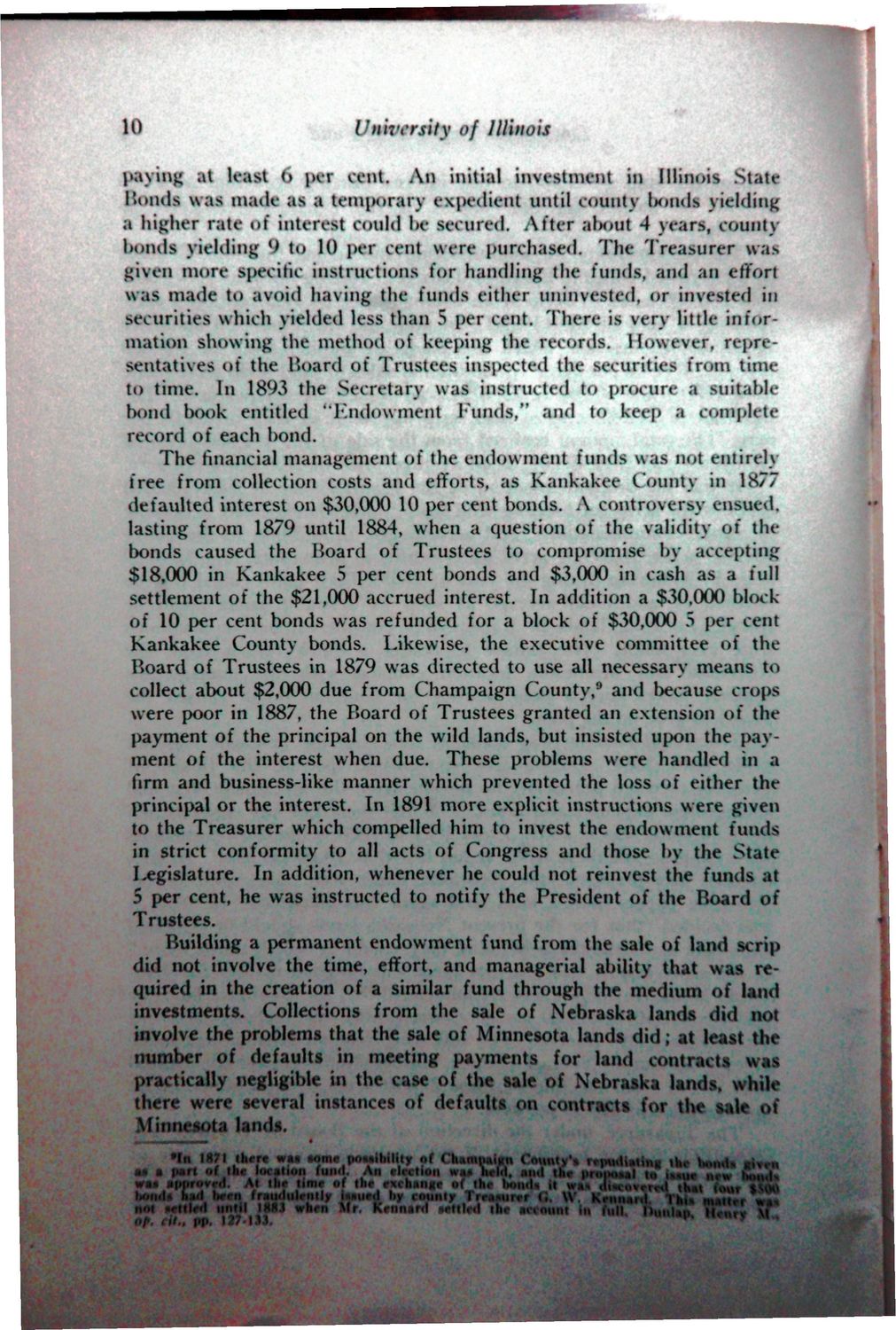| |
| |
Caption: Book - History of Illinois Land Grant Endowment
This is a reduced-resolution page image for fast online browsing.

EXTRACTED TEXT FROM PAGE:
10 University of Illinois paying at least O per cent. An initial investment in Illinois State Bonds was made as a temporary expedient until county bonds yielding a higher rate of interest could be secured. After about 4 years, count) { bonds yielding ) to 10 per cent were purchased. The Treasurer was given more specific instructions for handling the funds, and an effort was made to avoid having the funds either uninvested, or invested in securities which yielded less than 5 per cent. There is very little information showing the method of keeping the records. However, representatives of the Board of Trustees inspected the securities from time to time. In 1893 the Secretary was instructed to procure a suitable bond book entitled "Endowment Funds," and to keep a complete record of each bond. The financial management of the endowment funds was not entirely free from collection costs and efforts, as Kankakee County in 1877 defaulted interest on $30,000 10 per cent bonds. A controversy ensued, lasting from 1879 until 1884, when a question of the validity of tinbonds caused the Hoard of Trustees to compromise by accepting $18,000 in Kankakee 5 per cent bonds and $3,000 in cash as a full settlement of the $21,000 accrued interest. In addition a $30,000 block of 10 per cent bonds was refunded for a block of $30,000 S per cent Kankakee County bonds. Likewise, the executive committee of the Hoard of Trustees in 1879 was directed to use all necessary means to 9 collect about $2,000 due from Champaign County, and because crops were poor in 1887, the Hoard of Trustees granted an extension of the payment of the principal on the wild lands, but insisted upon the payment of the interest when due. These problems were handled in a firm and business-like manner which prevented the loss of either the principal or the interest. In 1891 more explicit instructions were given to the Treasurer which compelled him to invest the endowment funds in strict conformity to all acts of Congress and those by the State legislature. In addition, whenever he could not reinvest the funds at 5 per cent, he was instructed to notify the President of the Board of Trustees. Building a permanent endowment fund from the sale of land scrip did not involve the time, effort, and managerial ability that was required in the creation of a similar fund through the medium of land investments. Collections from the sale of Nebraska lands did not involve the problems that the sale of Minnesota lands did; at least the number of defaults in meeting payments for land contracts was practically negligible in the case of the sale of Nebraska lands, while there were several instances of defaults on contracts for the sate of Minnesota lands. • f n 1*71 r t W I I t ^ poiMtiiliit --, < |,. i n .,,.Jg| C o u n t y ' , rrpiftlUlittN ihe fat** • • * l » r i of tltr location fund. An r l u t i o u ^ u )« • i.l. m»| th. i >opo»«) i f , t%u\s Wftft fti'iit \ i tlif timr of tlir rxchttiiKC o f J h . IMHUU it .dst«v< ! th.it fcur t hoiid- h.,.1 h« .it, frwii ulr.ul> i^iied by county l i , . . . i . . . w KrmtAid matter * not -rttlffl i,i,t,i I8S3 whoi Mi Kctini. i i .tint ... full, hunlZp rJJVu \i
| |